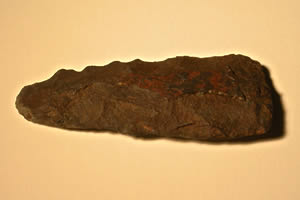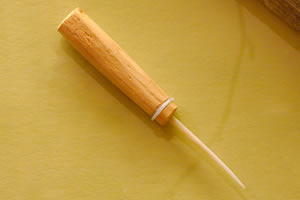|
|
|
|
  |
|

 |
2
of
5 |
|
|
|
Canoe Building Tools |
|
|
 |
|
|
Axes and Adzes
Before the arrival of European traders, stone adzes were used to cut the spruce
trees used for the frame of a birchbark canoe. With the arrival of Europeans,
the steel axe slowly became the woodcutter's tool of choice.
To cut down a tree with an adze, a man or woman would drive the adze into the
tree at an angle, producing a long, deep vertical slab. The slab could then
be pried back. The woodcutter then repeated the process at one side of the first
scar, until the tree had been completely encircled. When the trunk had been
sufficiently weakened, the tree was pushed over and snapped off.
|
|
 |
|
 |
|
 |
|
Awls
An awl is a spike with a wooden, bone or antler handle that is used to pierce
birchbark, creating holes for threading spruce roots. Today, awls are often made
by hammering a nail into a piece of wood, then cutting off the head of the nail
and sharpening it to a fine point. Long ago, before nails were available, bone
and antler were used to make awls.
|
|
 |
|
 |
|
 |
|
Crooked Knives
The crooked knife was another very important tool in canoe building. It was used
to shape spruce wood for the frame of the canoe, split spruce roots and cut birchbark.
Before European traders came, knives were made from stone. The edges of a flat
stone were chipped until a sharp blade formed. The teeth of a beaver were also
sometimes used for the knife blade.
|
|
 |
|
 |
|
|
|
|
|
|
|

